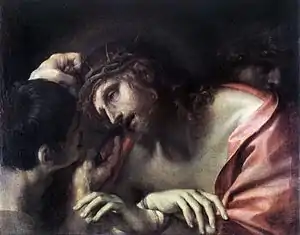Christ Crowned with Thorns (Annibale Carracci)
Christ Crowned with Thorns or Christ Mocked is a 1598-1600 oil on canvas painting by Annibale Carracci, now at the Pinacoteca Nazionale di Bologna.

History

It is usually identified with a work mentioned by Giulio Mancini in his Considerazioni sulla pittura (1620),[1] in which he refers to the artist painting a "Christ whipped and pulled by the hair for the chapels of the "manigoldi" in the manner of fra Bastiano [i.e. Sebastiano del Piombo]" as an angry riposte to comments from his patron Odoardo Farnese on the superiority of past painters over present ones. Odoardo then saw the work hanging on a wall of the Palazzo Farnese, mistook it for a work by Luciani and stated that it confirmed his previous assertion, to which Annibale immediately replied that the work's artist was by "the grace of God, [still] alive".
Like the rest of the Farnese collection, the work moved from Rome to Parma and finally to Naples. At the end of the 18th century it passed to an English collector before going back on the market and being acquired by the Italian state for its present owner in 1951.
Dating
This remains controversial.
Gallery
 Anthony van Dyck, Italian Notebook, 1621-1627, British Museum. The sketch of Carracci's Christ Crowned with Thorns in at the top of the folio above the study of Titian's Christ Crowned with Thorns (Louvre)
Anthony van Dyck, Italian Notebook, 1621-1627, British Museum. The sketch of Carracci's Christ Crowned with Thorns in at the top of the folio above the study of Titian's Christ Crowned with Thorns (Louvre) Print of Carracci's work by Sebastiano Vaiani, 1627
Print of Carracci's work by Sebastiano Vaiani, 1627
References
- Donald Posner, Annibale Carracci: A Study in the reform of Italian Painting around 1590, Londra, 1971, Vol. II, N. 89, pp. 38-39.
External links
- "Catalogue entry" (in Italian).
